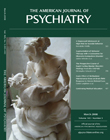Aripiprazole’s Receptor Pharmacology and Extrapyramidal Side Effects
To The Editor: In the September 2007 issue of the Journal , David Mamo, M.D., M.Sc., et al. (1) reported that at clinically effective doses (10–30 mg/day) aripiprazole exerts more than 80% striatal dopamine D 2 receptor occupancy in patients with schizophrenia. Correspondingly, higher striatal D 2 occupancy (>90%) was associated with the development of extrapyramidal side effects (dystonia, parkinsonism). Aripiprazole was distinguished by a low serotonin 5-HT 2 :D 2 affinity ratio (52% [SD=18%] versus 87% [SD=4%], respectively) and a low 5-HT 1A receptor occupancy (mean=16%) (1) . The authors implied that aripiprazole’s partial D 2 agonist properties accounted for a low propensity for extrapyramidal side effects.
In several controlled trials, the rate of aripiprazole-induced extrapyramidal side effects was reported similar to placebo; however, it was the rate of aripiprazole-induced akathisia reported as being significantly higher (approximately 20%) in patients with schizophrenia and bipolar mania (2 , 3) . The estimated rate of aripiprazole-induced akathisia in naturalistic settings has been shown to be even higher (4) . The pathophysiological mechanisms and treatment of akathisia differ from that of other extrapyramidal side effects. Anticholinergic agents that are efficacious in treating dystonia and parkinsonism are apparently ineffective in treating akathisia. In contrast, a robust anti-akathisia effect of mianserin and mirtazapine (both with marked 5-HT 2A antagonism), comparable with propranolol (the drug of choice for treating akathisia), has consistently been shown in patients treated with first-generation antipsychotic agents, underscoring the role of 5-HT 2A receptor antagonism in the pathophysiology and treatment of akathisia (5) . Preliminary evidence indicating an anti-akathisia effect of the selective 5-HT 2A inverse agonist ACP-3 (6) supports this assumption. Notably, the 5-HT 1A agonist buspirone was ineffective as an anti-akathisia agent (7) . We suggest that aripiprazole’s partial agonism at the D 2 and 5-HT 1A receptors accounts for the low incidence of extrapyramidal side effects but does not “protect” against akathisia. Noteworthy, five (42%) of 12 participants in the study developed restlessness (1) , which may well have been an expression of akathisia. A sufficient degree of the 5-HT 2A antagonism and a high 5-HT 2A :D 2 occupancy ratio are essential to prevent or ameliorate drug-induced akathisia. Elucidation of pathophysiological mechanisms and efficacious treatment of akathisia are imperative because of akathisia’s association with non-compliance and suicidal and violent behavior.
1. Mamo D, Graff A, Mizrahi R, Shammi CM, Romeyer F, Kapur S: Differential effects of aripiprazole on D 2 , 5-HT 2 , and 5-HT 1A receptor occupancy in patients with schizophrenia: a triple tracer PET study. Am J Psychiatry 2007; 164:1411–1417 Google Scholar
2. Fleischhacker W: Aripiprazole. Expert Opin Pharmacother 2005; 6:2091–2101Google Scholar
3. Kinghorn WA, McEvoy JP: Aripiprazole: pharmacology, efficacy, safety and tolerability. Expert Rev Neurother 2005; 5:297–307Google Scholar
4. Ghaemi SN, Hsu DJ, Rosenquist KJ, Pardo TB, Goodwin FK: Extrapyramidal side effects with atypical neuroleptics in bipolar disorder. Prog Neuropsychopharmacol Biol Psychiatry 2006; 30:209–213Google Scholar
5. Poyurovsky M, Pashinian A, Weizman R, Fuchs C, Weizman A: Low-dose mirtazapine: a new option in the treatment of antipsychotic-induced akathisia: a randomized, double-blind, placebo- and propranolol-controlled trial. Biol Psychiatry 2006; 59:1071-1077Google Scholar
6. Grahnen AE, Vanover KE, Weiner M, Nilsson L, Tolf B, Hacksel U, Davis MR: Reduction of haloperidol-induced side effects by ACP-103 in healthy volunteers. Clin Pharmacol Ther 2005; 77:P98–P99Google Scholar
7. Poyurovsky M, Weizman A: Serotonergic agents in the treatment of acute neuroleptic-induced akathisia: open-label study of buspirone and mianserin. Int Clin Psychopharmacol 1997; 12:263–268Google Scholar



